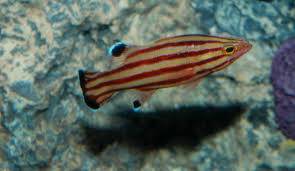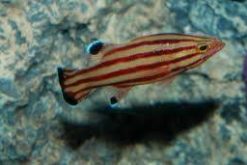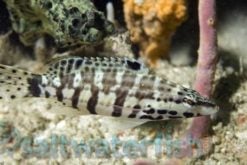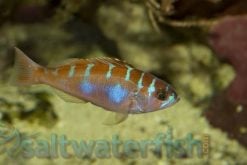Japanese Basslet – Leopropoma susumi
Quick Stats:
- Care Level: Moderate
- Temperament: Peaceful
- Diet: Carnivore
- Reef Safe: Yes
- Minimum Tank Size: 30 gallons
- Maximum Size: 3 inches
- Water Parameters: pH 8.1-8.4, salinity 1.023-1.025, temperature 72-78°F
Comprehensive Guide to the Japanese Basslet – Leopropoma susumi
Habitat:
The Japanese Basslet, also known as Leopropoma susumi, is found in the Western Pacific Ocean, specifically in the waters surrounding Japan. It typically inhabits rocky areas, caves, and coral reefs.
Reef Safe:
The Japanese Basslet is considered reef safe as it does not harm corals or other invertebrates. However, caution should still be exercised when introducing it to a reef tank with delicate or small-sized invertebrates.
Size:
The Japanese Basslet grows to a maximum size of around 3 inches, making it a relatively small fish suitable for smaller saltwater aquarium setups.
Temperament:
This species is known for its peaceful nature, making it a good choice for community tanks. It generally gets along well with other fish and does not exhibit aggressive behavior.
Sexual Dimorphism:
There is no visible sexual dimorphism in the Japanese Basslet, meaning it is difficult to visually determine the sex of the fish.
Lifespan:
With proper care and a suitable environment, the Japanese Basslet can live for several years in captivity. Its lifespan can range from 3 to 8 years or more.
Diet in Aquariums:
In the aquarium, the Japanese Basslet is a carnivorous species. It should be fed a varied diet consisting of high-quality frozen or live foods such as brine shrimp, mysis shrimp, and small pieces of meaty seafood. Offering a mix of protein-rich foods will help ensure their nutritional needs are met.
Aquascaping Recommendations:
To provide a suitable environment for the Japanese Basslet, it is recommended to create a rocky aquascape with plenty of hiding spots and caves. This will mimic its natural habitat and give the fish a sense of security.
Captive Bred Availability:
The Japanese Basslet is rarely available as captive bred. Most specimens in the aquarium trade are wild-caught. However, captive breeding efforts are being made to reduce the impact on wild populations.
Compatibility with Other Fish, Invertebrates, or Corals:
The Japanese Basslet is generally compatible with other peaceful fish species, as it does not show aggression towards tankmates. It can also coexist with most invertebrates and corals in a reef tank. However, caution should be taken when pairing it with aggressive or territorial fish.
Five Recommended Tankmates:
- Firefish – Peaceful and colorful, adds activity to the tank.
- Banggai Cardinalfish – Peaceful and visually striking, enhances the overall aesthetics of the tank.
- Yellow Watchman Goby – Peaceful and a great addition to a sand bed area.
- Purple Firefish – Peaceful and vibrant, brings a pop of color to the tank.
- Clownfish – Peaceful and iconic, adds personality and interaction to the aquarium.
People should consider buying from Reefs4Less.com because they are a reputable online retailer that specializes in saltwater aquarium supplies. They offer a wide selection of high-quality fish and invertebrates, including the Japanese Basslet. Their commitment to customer satisfaction and reliable shipping makes them a trusted choice for saltwater enthusiasts.
Popular Questions and Answers:
1. Can the Japanese Basslet be kept in a nano reef tank?
Yes, the Japanese Basslet can thrive in a nano reef tank as long as the tank size meets the minimum requirement of 30 gallons and the water parameters are properly maintained.
2. Does the Japanese Basslet require any specific water flow in the aquarium?
The Japanese Basslet prefers moderate water flow in the aquarium. It should not be exposed to strong or turbulent currents, as it may cause stress or difficulty in swimming.
3. Can the Japanese Basslet be kept with aggressive fish?
It is generally not recommended to keep the Japanese Basslet with aggressive or territorial fish, as it may become a target of aggression or stress. It is best to choose peaceful tankmates for this species.
4. How often should the Japanese Basslet be fed?
The Japanese Basslet should be fed small amounts of food multiple times a day. It is recommended to feed them 2-3 times daily to ensure they receive enough nutrition and to mimic their natural feeding habits.
5. Can the Japanese Basslet jump out of the aquarium?
While not known for being excessive jumpers, it is always a good idea to have a secure lid or cover on the aquarium to prevent any potential accidents. Providing ample hiding places within the tank can also help reduce the likelihood of jumping.
| Size | 1 – 2 inches |
|---|






Reviews
There are no reviews yet.